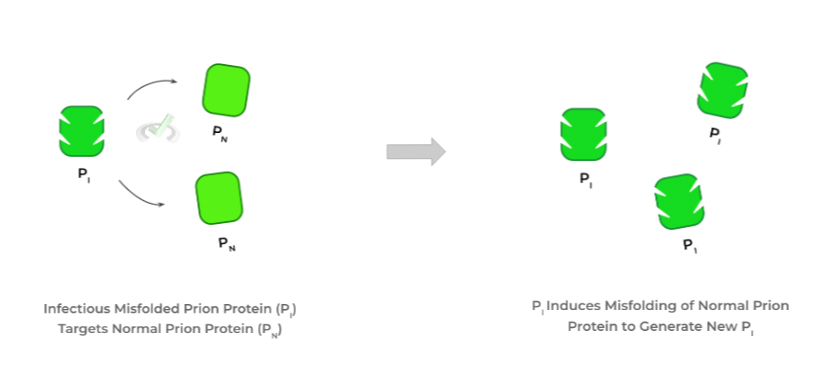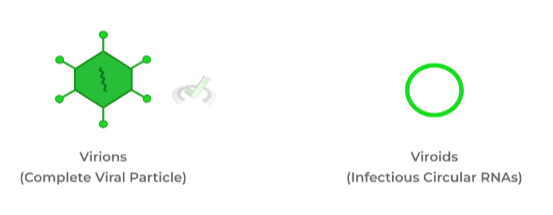I. What are Prion and Viroid Subviral Particles?
Think we couldn’t get smaller than viruses? Think again! Through recent research and studies, molecular biologists have found infectious viral particles whose size even dwarfs that of viruses, those being prions and viroids.
Until these recent research discoveries, obligate, nonliving intracellular parasites were thought to always require at least a protein coat and genetic material as seen in viruses. However, as you’ll see soon, these subviral particles were shown to break this rule.
When compared to other articles on the MCAT, this is definitely another low yield topic! Likewise, we’d like to mention that because these discoveries are relatively new, much of our understanding is still limited and undergoing constant development,
II. Prions and Viroids
2 of the most studied subviral particles include prions and viroids. Let’s take a look at their characteristics and what makes them unique from viruses!
A. Prions
These subviral particles are misfolded, infectious proteins responsible for some neurodegenerative diseases. Unlike viruses, prions don’t have any nucleic acids associated with the proteins.
Prions are actually a normal cellular protein found within neurons and can come in 2 forms: a normal form (PN) and a misfolded infectious form (PI).

Though their function is not well known, we know that when PI isoform contacts a Pn prion, it can cause misfolding of the PN prion and convert it into an infectious PI form.
When aggregated together, the PI prions cause neuron cell apoptosis, creating cysts giving the brain a “sponge like” appearance as seen in Creutzfeldt-Jakob disease.B. Viroids
Thes subviral particles are literally composed of infectious small, circular RNAs primarily infecting plant cells! Unlike viruses, they lack the protein coat surrounding the nucleic acid.
It’s thought that viroids cause disease in plants by host cell mRNA silencing, where viroids generate siRNAs having complementary base pairs to plant mRNAs and repressing expression

III. Bridge/Overlap
While viroids are a type of subviral infectious particle, make sure not to confuse them with a similar term with similar spelling: virions! Make sure to differentiate between these 2 terms!
I. Virions v.s. Viroids
We’ll keep this part short and sweet! A virion refers to a single viral particle, which consists of a protein capsid shell enclosing a nucleic acid genome and may or may not have an enveloped lipid membrane.
Viroids refer to the subviral, infectious circular RNA molecules which primarily infect plants and cause disease through mRNA silencing.

IV. Wrap Up/Key Terms
Let’s take this time to wrap up & concisely summarize what we covered above in the article!
A. Prions
These subviral particles are actually misfolded, infectious versions of a normal prion protein found within neurons. When the PI isoforms come into contact with normal PN prions. , they can also induce their misfolding and conversion to a PI infectious form.
The build of PI aggregates within the neurons eventually causes apoptosis resulting in neuron cell death and can cause cysts within the brain.
B. Viroids
These subviral particles are composed of infectious small, circular RNA molecules primarily infecting plant cells. It’s thought they cause disease through RNA silencing through the production of siRNAs.
V. Practice
Take a look at these practice questions to see and solidify your understanding!
Sample Practice Question 1
Which of the following would NOT be found in the siRNAs produced by viroids?
A. Adenine
B. Guanine
C. Uracil
D. Thymine
Ans. D
This just comes back to understanding the nucleotide composition of DNA and RNA. Recall that in RNA, uracil bases take the place of thymine!
Sample Practice Question 2
Which of the following would best describe the action of viroid siRNAs?
A. Pre-Transcriptional Modification
B. Pre-Translation Modification
C. Post-Translational Modification
D. Pre-Replication Modification
Ans. B
The siRNAs from the viroid genome form complementary base pairs with the host’s mRNA causing RNA silencing. This occurs after transcription of the mRNA but before its been able to be translated into a functional protein.







 To help you achieve your goal MCAT score, we take turns hosting these
To help you achieve your goal MCAT score, we take turns hosting these 





















 reviews on TrustPilot
reviews on TrustPilot